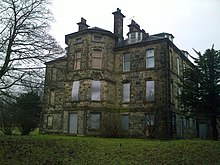Cumbernauld House
Cumbernauld House is a castle in the Scottish town of Cumbernauld in the North Lanarkshire Council Area . It is located in the northeast of the city in an extensive park area. In 1971 Cumbernauld House was listed in the Scottish Monuments List in the highest category A.
history
Cumbernauld Castle
The site of Cumbernauld House was once a castle called Cumbernauld Castle , the construction of which is dated around 1370. Coins and shards found in an excavation to the northeast of what is now Cumbernauld House show that they were made during this period. During the English Civil War , a troop of dragoons largely destroyed the castle. In 1650 the order was issued to occupy the castle with troops against the advancing Oliver Cromwell . During the battle for Cumbernauld Castle, the castle was finally destroyed. Cumbernauld Castle is still shown on a map around 1750, so it can be assumed that at least ruins were still there at that time. Today there are no visible remains of the castle.
Cumbernauld House
Today's Cumbernauld House was probably built partially on the ruins of the old castle, with recoverable material from the ruins also being reused. The construction was completed in 1731. The well-known Scottish architect William Adam is responsible for the designs . Cumbernauld Castle was owned by John Fleming, 1st Earl of Wigtown , a notorious opponent of the Act of Union of 1707 and a Scottish royalist. For this reason, Fleming was already imprisoned in Edinburgh Castle during the First Jacobite Rising in 1715 . During the Second Jacobite Rising in 1745, troops from Bonnie Prince Charlie were stationed in Cumbernauld. Dragoons used the ruins of Cumbernauld Castle as stables. An accident broke out a fire which devastated the ruins again. After recyclable material was removed for further construction at Cumbernauld House, the site was later leveled.
In 1822, Clementina Maude, Viscountess Hawarden , one of the first female photographers whose work is now managed by the Victoria and Albert Museum in London , was born in Cumbernauld House. In the 1870s the property was modernized and was inhabited until 2007 when the last private owner ran into financial difficulties. It was proposed to set up an exhibition of the National Museum of Photography in Cumbernauld House . In 2008 the castle was added to the Scottish register of endangered listed structures. However, the risk was classified as minimal and the building fabric as good.
In 2009, Cumbernauld House went up for sale for £ 1 million . With the Cumbernauld House Trust , a non-profit organization was founded in 2010 with the aim of achieving a long-term perspective for Cumbernauld House. The fundraising was supported by the SNP MP Jamie Hepburn and discussed in a parliamentary session. Refurbishment measures began in 2011.
Individual evidence
- ↑ Listed Building - Entry . In: Historic Scotland .
- ↑ a b Entry on Cumbernauld House in Canmore, the database of Historic Environment Scotland (English)
- ↑ a b Information about Cumbernauld House ( Memento of February 8, 2013 in the Internet Archive )
- ↑ Entry on buildingsatrisk.org.uk ( memento of the original from October 14, 2012 in the Internet Archive ) Info: The archive link was inserted automatically and has not yet been checked. Please check the original and archive link according to the instructions and then remove this notice.
Web links
- Entry on Cumbernauld House in Canmore, Historic Environment Scotland database
Coordinates: 55 ° 57 ′ 37.6 " N , 3 ° 58 ′ 4.2" W.


